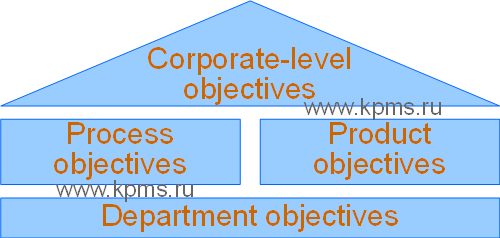Setting quality objectives is the next stage of the "deployment" of the quality system in the organization after policy development. The ISO 9001:2015 standard requires that quality objectives are established, relate to all departments and management levels of the organization and are necessarily measurable. Meeting this requirement implies documenting quality objectives.
Quality objectives
Quality objectives are a hierarchical structure. There are objectives related to the entire organization at the high level. Further, these objectives are divided to the level of individual divisions (organizational units). Quality goals are detailed to the level of individual employees in some organizations. However, if a quality system is just being built, such a level of detail will only harm, because there are usually no appropriate mechanisms to obtain reliable information about achieving these goals.
Quality objectives are the basis for the development of specific plans and the implementation of actions, therefore, the formulation of objectives must be carried out according to certain rules. One of the variants of the rules for setting objectives can be the SMART rule. The formulation of objectives using this rule allows you to develop effective objectives, the achievement of which is easy to control.
First, the goal must be Specific. This means that according to the formulation of the objective you can unambiguously to understand the result that need to be achieved.
Secondly, the objective must be Measurable. This means you can assign a specific indicator to each objective. The measurability of the objective can be quantitative or qualitative. A qualitative indicator is used when it is impossible or simply not advisable to measure the result in numerical values.
Thirdly, the formulation of the objective should motivate to achieve it (Attractive). Employees will have no interest in achieving objective if the objective is too easy. Therefore, the objective must be set in such a way that the difficulty of achieving it causes satisfaction from the efforts expended.
Fourth, the objective should be realistic. If you set obviously unattainable objective, then there will be no incentive to achieve such objective.
Fifth, the objective should be limited in time (Time framed). It is necessary to allocate a strictly defined period of time to achieve the objective. This will allow you to monitor the achievement of the goal and, if necessary, adjust efforts to achieve it.
In addition to the above rules, it is important to take into account one more point – the goals should be specific, but "flexible". A lot can change in the course of the implementation of the plans. The initial conditions for achieving the objectives may not be confirmed, or they may not be realistic to fulfill. Therefore, it is necessary to provide for the stages of revision and updating of objectives when they setting. These stages are also necessary to include in the document – "quality objectives". Quality objectives can be part of the strategic goals of the organization, make up tactical goals and be operational goals. When a quality system is just being built in an organization, quality objectives are usually set for a period of one year.
Types of quality objectives
The structuring of quality objectives can be performed in different ways depending on the size of the organization, the complexity of its processes and the level of development of management technologies.
As a rule, quality objectives are structured as follows:

- Corporate-level quality objectives. They relate to the entire organization. These objectives are components of strategic goals. Corporate-level goals are detailed into objectives by divisions, objectives by processes, and objectives by products. Qualitative indicators are mainly used to measure the achievement of these objectives. Setting corporate-level objectives can be carried out on the basis of BSC (Balanced Scorecard) technology. However, it is better to use the simplest methods for organizations with a low level of development of management technologies at the initial stages of implementing a quality system – for example, the expert opinion of top management.
- Quality objectives by department. They detail corporate-level objectives. If the organization is small, then such details are usually not carried out. The departments responsible for achieving of objectives are indicated when corporate-level goals are developing.
Department objectives contain process objectives and product objectives as separate components. There are situations when a process begins and ends in one department or the release of any type of product is carried out by one department. Objectives for a specific process or objectives for a specific type of product become the objectives of the division in this case. Objectives for divisions should have numerical, measurable indicators.
- Process quality objectives. They represent the performance characteristics of processes that must be achieved in order to ensure the desired level of product (service) quality. The detailing of process objectives depends on the accepted (or assumed, if the quality system is just being built) process detailing. A hierarchical system of process objectives is established for each of the process levels.
- Quality objectives for products (services). They represent the desired (expected) level of fulfillment of customer requirements for products or services provided by the organization. The minimum level of requirements is the full compliance of the product (service) with all the requirements of the contract or technical conditions.
Documenting quality objectives
Documenting quality objectives is a prerequisite for monitoring their achievement, tracking their adequacy and relevance, as well as evaluating the correctness of decisions made aimed at developing a quality system. Options for documenting quality objectives are determined by the period of their setting and the level of detail.
Long–term quality objectives set for a period of one year or more relate to the strategic goals of the organization - these are corporate-level goals. It is customary to document such quality objectives in the development concept. It is necessary to define the criteria for achievement, the periods for obtaining intermediate results and targets, as well as clearly define responsibility for the result for each goal. The periods of analysis and revision of corporate quality objectives will coincide with the established periods of analysis of the organization's work. As a rule, this is summing up the results for the year when the final management and accounting statements are being prepared.
Quality objectives for departments, processes and products are usually set for a period of up to one year, so their documentation can be carried out both in separate documents and as part of the existing management documentation of the organization. A separate document presenting quality objectives structured across all departments, across all processes and across all products of an organization can be created by a quality management representative. The separation of quality objectives into process objectives, product objectives, and unit objectives is usually not advisable for the head of a separate department. In this case, all the objectives of the division are consolidated into a single system of objectives of a particular division and documented either in a separate document or included in the production plan (or work plan) for a year, quarter, month, depending on the adopted planning system.
